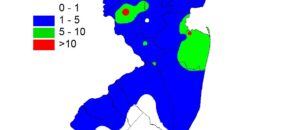The Cash Rents Survey estimates have been published by the National Agriculture Statistical Survey Office. Survey responders reported an average cropland rental rate of $76/acre across the state ranging from $46 an acre on average for pasture; $66/acre on average for non-irrigated cropland; and $128/acre on average for irrigated cropland. The link to the data […]
Continue reading...USDA Surveying Producers Small Grain Production
USDA to Measure Small Grain Production “HARRISBURG, PA – During the first two weeks of September, a sample of small grains growers around the country will receive Agricultural Survey questionnaires from the U.S. Department of Agriculture’s National Agricultural Statistics Service (NASS). The agency is taking a comprehensive look into the 2021 production and supply of […]
Continue reading...Free Official Scrapies Eartag Options for Sheep and Goat Producers
Have goats or sheep? Read the update from the USDA regarding how to receive your free metal ear tag. “The United States Department of Agriculture’s Animal and Plant Health Inspection Service (APHIS), National Scrapie Eradication Program, is providing up to 100 plastic flock ID tags free-of-charge, to first time participants in the sheep and goat […]
Continue reading...Aflatoxin test drought stressed corn before feeding
As anticipated, the weather conditions during corn silking when high heat coupled with little precipitation has yielded a corn grain crop in many parts of the state with visible signs of lighter test weights on the cob and signs of mold proliferation. Field dry, low test weight kernals are very likely to crack before or […]
Continue reading...Controlling fungal leaf blights of Carrot
Powdery mildew, Alternaria and Cercospora are three important fungal foliar pathogens that can cause early defoliation in carrots, thus reducing yields and making harvest difficult. Each pathogen produces distinct symptoms.
Continue reading...Vegetable IPM Update 08/18/21

Sweet Corn European corn borer (ECB) moths are still appearing in several locations, but numbers remain very low, and feeding has only occasionally been reported. ECB population maps will resume if second flight catches rise to high enough numbers. The highest nightly blacklight trap catches of ECB for the week ending 08/18/21 are as follows: […]
Continue reading...